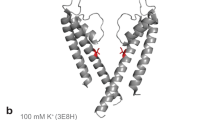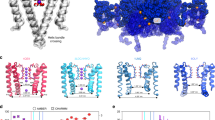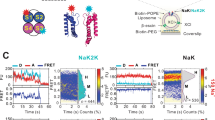Abstract
K+ channels are transmembrane proteins that are essential for the transmission of nerve impulses. The ability of these proteins to conduct K+ ions at levels near the limit of diffusion is traditionally described in terms of concerted mechanisms in which ion-channel attraction and ion–ion repulsion have compensating effects, as several ions are moving simultaneously in single file through the narrow pore1,2,3,4. The efficiency of such a mechanism, however, relies on a delicate energy balance—the strong ion-channel attraction must be perfectly counterbalanced by the electrostatic ion–ion repulsion. To elucidate the mechanism of ion conduction at the atomic level, we performed molecular dynamics free energy simulations on the basis of the X-ray structure of the KcsA K+ channel4. Here we find that ion conduction involves transitions between two main states, with two and three K+ ions occupying the selectivity filter, respectively; this process is reminiscent of the ‘knock-on’ mechanism proposed by Hodgkin and Keynes in 19551. The largest free energy barrier is on the order of 2–3 kcal mol-1, implying that the process of ion conduction is limited by diffusion. Ion–ion repulsion, although essential for rapid conduction, is shown to act only at very short distances. The calculations show also that the rapidly conducting pore is selective.
This is a preview of subscription content, access via your institution
Access options
Subscribe to this journal
Receive 51 print issues and online access
$199.00 per year
only $3.90 per issue
Buy this article
- Purchase on Springer Link
- Instant access to full article PDF
Prices may be subject to local taxes which are calculated during checkout




Similar content being viewed by others
References
Hodgkin, A. L. & Keynes, R. D. The potassium permeability of a giant nerve fibre. J. Physiol. 128, 61–88 (1955).
Hille, B. & Schwarz, W. Potassium channels as multi-ion single-file pores. J. Gen. Physiol. 72, 409–442 (1978).
Neyton, J. & Miller, C. Discrete Ba2+ block as a probe of ion occupancy and pore structure in the high-conductance Ca2+-activated K+ channel. J. Gen. Physiol. 92, 569–586 (1988).
Doyle, D. A. et al. The structure of the potassium channel: molecular basis of K+ conduction and selectivity. Science 280, 69–77 (1998).
Roux, B. & MacKinnon, R. The cavity and pore helices in the KcsA K+ channel: electrostatic stabilization of monovalent cations. Science 285, 100–102 (1999).
Karplus, M. & Petsko, G. A. Molecular dynamics simulations in biology. Nature 347, 631–639 (1990).
Guidoni, L., Torre, V. & Carloni, P. Potassium and sodium binding to the outer mouth of the K+ channel. Biochem. 38, 8599–8604 (1999).
Shrivastava, I. H. & Sansom, M. S. Simulations of ion permeation through a potassium channel: molecular dynamics of KcsA in a phospholipid bilayer. Biophys. J. 78, 557–570 (2000).
Allen, T. W., Bliznyuk, A., Rendell, A. P., Kuyucak, S. & Chung, S. H. The potassium channel: structure, selectivity and diffusion. J. Chem. Phys. 112, 8191–8204 (2000).
Aqvist, J. & Luzhkov, V. Ion permeation mechanism of the potassium channel. Nature 404, 881–884 (2000).
Bernèche, S. & Roux, B. Molecular dynamics of the KcsA K(+) channel in a bilayer membrane. Biophys. J. 78, 2900–2917 (2000).
Kirkwood, J. G. Statistical mechanics of fluid mixtures. J. Chem. Phys. 3, 300–313 (1935).
Roux, B. Statistical mechanical equilibrium theory of selective ion channels. Biophys. J. 77, 139–153 (1999).
Torrie, G. M. & Valleau, J. P. Nonphysical sampling distributions in Monte Carlo free-energy estimation: umbrella sampling. J. Comp. Phys. 23, 187–199 (1977).
Alcayaga, C., Cecchi, X., Alvarez, O. & Latorre, R. Streaming potential measurements in Ca2+-activated K+ channels from skeletal and smooth muscle. Coupling of ion and water fluxes. Biophys. J. 55, 367–371 (1989).
Schumaker, M. F. & MacKinnon, R. A simple model for multi-ion permeation. single-vacancy conduction in a simple pore model. Biophys. J. 58, 975–984 (1990).
Armstrong, C. M. Induced inactivation of the potassium permeability of squid axon membranes. Nature 219, 1262–1263 (1968).
Crouzy, S., Berneche, S. & Roux, B. Extracellular blockade of K+ channels by TEA: results from molecular dynamics simulations of the KcsA channel. J. Gen. Physiol. 118, 207–218 (2001).
Eisenman, G. Cation selective electrodes and their mode of operation. Biophys. J. 2 (Suppl. 2), 259–323 (1962).
Kollman, P. A. Free energy calculations: applications to chemical and biochemical phenomena. Chem. Rev. 93, 2395–2417 (1993).
Perozo, E., MacKinnon, R., Bezanilla, F. & Stefani, E. Gating currents from a nonconducting mutant reveal open-closed conformations in Shaker K+ channels. Neuron 11, 353–358 (1993).
Lauger, P. A channel mechanism for electrogenic ion pumps. Biochim. Biophys. Acta 552, 143–161 (1979).
Brooks, B. R. et al. CHARMM: a program for macromolecular energy minimization and dynamics calculations. J. Comput. Chem. 4, 187–217 (1983).
Essmann, U. et al. A smooth particle mesh Ewald method. J. Chem. Phys. 103, 8577–8593 (1995).
Feller, S. E., Zhang, Y. H., Pastor, R. W. & Brooks, B. R. Constant pressure molecular dynamics simulation—the Langevin piston method. J. Chem. Phys. 103, 4613–4621 (1995).
MacKerell, A. D. Jr et al. All-atom empirical potential for molecular modeling and dynamics studies of proteins. J. Phys. Chem. B 102, 3586–3616 (1998).
Schlenkrich, M. J., Brickmann, J., MacKerell, A. D. Jr & Karplus, M. in Biological Membranes. A Molecular Perspective from Computation and Experiment (eds Merz, K. M. & Roux, B.) 31–81 (Birkhauser, Boston, 1996).
Jorgensen, W. L., Chandrasekhar, J., Madura, J. D., Impey, R. W. & Klein, M. L. Comparison of simple potential functions for simulating liquid water. J. Chem. Phys. 79, 926–935 (1983).
Beglov, D. & Roux, B. Finite representation of an infinite bulk system: solvent boundary potential for computer simulations. J. Chem. Phys. 100, 9050–9063 (1994).
Kumar, S., Bouzida, D., Swendsen, R. H., Kollman, P. A. & Rosenberg, J. M. The weighted histogram analysis method for free-energy calculations on biomolecules. I. The method. J. Comp. Chem. 13, 1011–1021 (1992).
Acknowledgements
Discussions with R. MacKinnon and J. Cabral are gratefully acknowledged. This work was supported by the National Institutes of Health and by the Canadian Institutes of Health Research. Several calculations were performed at the RQCHP Computer Center of the University of Montreal and at the National Center for Supercomputing Applications (NCSA) of the University of Illinois at Urbana-Champaign. We are grateful to B. Lorazo for his support. All the molecular pictures were drawn with DINO (A. Philippsen).
Author information
Authors and Affiliations
Corresponding author
Rights and permissions
About this article
Cite this article
Bernèche, S., Roux, B. Energetics of ion conduction through the K+ channel. Nature 414, 73–77 (2001). https://doi.org/10.1038/35102067
Received:
Accepted:
Issue Date:
DOI: https://doi.org/10.1038/35102067
This article is cited by
-
2D CdPS3-based versatile superionic conductors
Nature Communications (2023)
-
The Donnan potential revealed
Nature Communications (2022)
-
On the Role of a Conserved Methionine in the Na+-Coupling Mechanism of a Neurotransmitter Transporter Homolog
Neurochemical Research (2022)
-
New Structural insights into Kir channel gating from molecular simulations, HDX-MS and functional studies
Scientific Reports (2020)
-
The Ca2+ permeation mechanism of the ryanodine receptor revealed by a multi-site ion model
Nature Communications (2020)
Comments
By submitting a comment you agree to abide by our Terms and Community Guidelines. If you find something abusive or that does not comply with our terms or guidelines please flag it as inappropriate.



